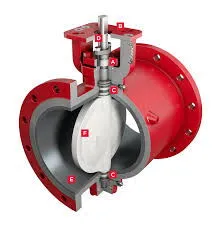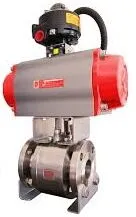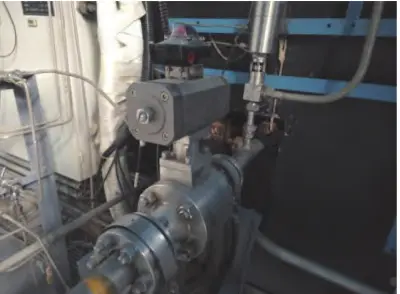High-Corrosion and Erosion-Resistant Ceramic Valves
Dec 11, 2024
On this page
Abstract: Conventional metal valves used in soda ash production cannot withstand the severe conditions of corrosion, high wear, and material fouling. This paper introduces a new type of ceramic valve designed to resist high corrosion and erosion, specifically for the soda ash industry. It provides a detailed overview of the structural design, technical features, and performance of ceramic angle valves, fully lined ceramic butterfly valves, and wear-resistant ceramic valves.
The soda ash production process involves a complex gas-liquid-solid three-phase reaction. Compared to other chemical processes, such as synthetic ammonia and ethylene production, which involve simpler gas-liquid reactions, soda ash production is more complex. The main challenges include solid deposition, crystallization, fouling, and corrosion from strong electrolytes (such as mixed solutions containing NH₄OH and NaCl, which are prone to volatilization and electrochemical corrosion. Additionally, lime slurry, containing particles and stones, is highly corrosive, viscous, and prone to clogging, leading to severe wear. These challenges complicate both operations and automation, hindering efficiency. Equipment performance, particularly the internal and external surfaces, must meet high standards to prevent electrochemical corrosion.
Stainless steel valves are commonly used to address corrosion, fouling, and exposure to corrosive gases and chemicals. However, due to the presence of these corrosive media, both the valve and its actuator are prone to corrosion over time. Prolonged use leads to crystal formation between the valve core, seat, and sealing surface. This increases the opening and closing torque, making operation more difficult and potentially causing the actuator to malfunction or fail to open. Forcing the valve open or closed under these conditions can damage the actuator, compromising both valve operation and the overall pipeline system. Despite advancements in the design and materials of metal valves, their structural and material limitations prevent them from withstanding harsh conditions, such as high wear and severe corrosion. This is particularly evident in their short service life and tendency to leak, both of which significantly compromise system stability.
Stainless steel valves are commonly used to address corrosion, fouling, and exposure to corrosive gases and chemicals. However, due to the presence of these corrosive media, both the valve and its actuator are prone to corrosion over time. Prolonged use leads to crystal formation between the valve core, seat, and sealing surface. This increases the opening and closing torque, making operation more difficult and potentially causing the actuator to malfunction or fail to open. Forcing the valve open or closed under these conditions can damage the actuator, compromising both valve operation and the overall pipeline system. Despite advancements in the design and materials of metal valves, their structural and material limitations prevent them from withstanding harsh conditions, such as high wear and severe corrosion. This is particularly evident in their short service life and tendency to leak, both of which significantly compromise system stability.
Ceramic valves are known for their exceptionally high hardness in both the sealing surface and components that come into contact with the fluid (Rockwell HRA ≥88, equivalent to Rockwell HRC ≥70). These valves provide stable performance, with key components offering outstanding self-lubricating properties. As a result, they require low torque and are easily controlled remotely. In harsh operating environments, ceramic valves deliver significant advantages and superior performance over valves made from other materials, particularly in chemical pipelines.
With growing emphasis on environmental protection, economic efficiency, and performance, coupled with continuous technological advancements, the application of ceramic valves is expanding. Their mechanical properties are increasingly stable, and their economic value continues to rise. Under conditions of severe corrosion and erosion, ceramic valves can last 2 to 5 times longer than rare metal valves, such as those made from titanium or nickel.
With growing emphasis on environmental protection, economic efficiency, and performance, coupled with continuous technological advancements, the application of ceramic valves is expanding. Their mechanical properties are increasingly stable, and their economic value continues to rise. Under conditions of severe corrosion and erosion, ceramic valves can last 2 to 5 times longer than rare metal valves, such as those made from titanium or nickel.
The goal is to leverage advanced materials, processes, and technologies to develop a product that offers enhanced functionality, extended service life, and improved energy efficiency with environmental benefits.
Ceramic angle valves offer significantly longer service life—up to 10 times longer—than conventional metal valves. Specifically engineered for the alkali industry, where the media are highly abrasive, corrosive, viscous, and prone to sticking, these valves outperform traditional metal valves, which typically fail within 15 days to 2 months due to severe erosion, leakage, and inadequate flow regulation. Frequent leakage and required repairs not only disrupt operations but also impose environmental and economic challenges. These valves incorporate structural ceramics with minimal deformation and significantly higher mechanical strength compared to metals. Ceramics have smaller crystal ion radii, higher ion charges, and larger coordination numbers, resulting in exceptional tensile and compressive strength, elasticity, hardness, and durability. When combined with our precision 360° grinding technology, ceramic angle valves are highly resistant to corrosion, abrasion, and wear, offering a tight, zero-leakage seal. This improves operational efficiency, ensures better sealing within pipeline systems, and enhances the safety and stability of supporting equipment. Additionally, ceramic valves contribute to energy savings and environmental protection.
In contrast, the metal valves used by Lianyungang Alkali Industry for handling heavy alkali ash emulsion require high-pressure water guns at the upper flange to flush the media before valve operation. This process reduces crystal formation, lowers torque, and facilitates smoother operation. However, this requires 110,000 tons of water annually. The ceramic angle valve eliminates the need for high-pressure flushing, saving both water and energy. Moreover, its service life exceeds one year, more than 10 times that of conventional metal valves, while costing only 3 to 5 times more. It also reduces downtime for inspections and maintenance, providing significant cost savings to enterprises.

Figure 1 Comparison of ordinary metal angle valves and a new type of ceramic angle valves used in gray emulsion media
In contrast, the metal valves used by Lianyungang Alkali Industry for handling heavy alkali ash emulsion require high-pressure water guns at the upper flange to flush the media before valve operation. This process reduces crystal formation, lowers torque, and facilitates smoother operation. However, this requires 110,000 tons of water annually. The ceramic angle valve eliminates the need for high-pressure flushing, saving both water and energy. Moreover, its service life exceeds one year, more than 10 times that of conventional metal valves, while costing only 3 to 5 times more. It also reduces downtime for inspections and maintenance, providing significant cost savings to enterprises.

Figure 1 Comparison of ordinary metal angle valves and a new type of ceramic angle valves used in gray emulsion media
The fully lined ceramic butterfly valve is designed with a straight pipe flow channel to maximize the effective flow area when fully opened. This design minimizes flow resistance and eliminates dead zones, ensuring efficient fluid control. The valve is ideal for large-diameter applications and environments with high solid particle content, as it minimizes liquid retention at the pipe port. It is also engineered to withstand extreme conditions involving high friction losses, such as corrosive slurries, salt mud, and alumina smelting. The outlet end is twice the length of the inlet end, an engineering feature that protects the valve from scouring by high-velocity media when the flow rate is low.
The valve has been proven effective in the following applications:
Brine Refining Section at Tian Biochemical Co., Ltd. (alkali solution and ash milk mixture): In this application, the alkali solution and ash milk mixture, which is both corrosive and abrasive, is separated from sand after precipitation. Initially, metal ball valves were used, but they suffered from issues such as jamming and damage to the sealing surface due to solid particles. The fully lined ceramic butterfly valve solved these problems by offering superior corrosion and abrasion resistance. Its optimized structural design improved opening and closing performance, preventing damage to the sealing surface from large particles. Brine Refining Section Conveying Salt Mud Medium: This medium, which contains Mg(OH)₂, CaCO₃, BaSO₄, and mud sand, has a high chloride content and requires valves with exceptional wear and corrosion resistance. Traditional metal valves were unsuitable for this application. The SUNYEH ceramic regulating valve, installed in May 2015, has demonstrated a service life of over five years and continues to perform effectively.

The valve has been proven effective in the following applications:
Brine Refining Section at Tian Biochemical Co., Ltd. (alkali solution and ash milk mixture): In this application, the alkali solution and ash milk mixture, which is both corrosive and abrasive, is separated from sand after precipitation. Initially, metal ball valves were used, but they suffered from issues such as jamming and damage to the sealing surface due to solid particles. The fully lined ceramic butterfly valve solved these problems by offering superior corrosion and abrasion resistance. Its optimized structural design improved opening and closing performance, preventing damage to the sealing surface from large particles. Brine Refining Section Conveying Salt Mud Medium: This medium, which contains Mg(OH)₂, CaCO₃, BaSO₄, and mud sand, has a high chloride content and requires valves with exceptional wear and corrosion resistance. Traditional metal valves were unsuitable for this application. The SUNYEH ceramic regulating valve, installed in May 2015, has demonstrated a service life of over five years and continues to perform effectively.

In the alkali production process, particulate matter causes significant wear on equipment. During furnace gas transport, the high concentration of carbon dioxide leads to the formation of ammonium bicarbonate crystals as the temperature drops. Similarly, in the condensation tower, NH₄HCO₃ crystals often precipitate, complicating valve operation. Forced valve operation under these conditions can cause damage. The bottom valve in the ammonia tower is particularly vulnerable to crystallization and wear. Additionally, the alkali industry’s complex and long input pipelines and process flows for salt and limestone make operations more challenging. Conventional metal valves fail to meet these demands, with their short service life and frequent need for replacement leading to significant operational disruptions. Ceramic valves, however, effectively address corrosion, erosion, and wear, thanks to their superior material properties. A newly developed structural design further mitigates issues related to crystallization and wear, enhancing valve durability and performance.
Valves used in specialized applications are typically imported, making them expensive and subject to long inspection and maintenance cycles, with limited after-sales support. However, with the advancement of ceramic materials and innovations in valve technology, ceramic valves have demonstrated outstanding performance in addressing the challenging conditions found in industries such as alkali, coal chemical, fine chemical, petroleum, and chemicals. As a result, ceramic valves are increasingly replacing imported alternatives, providing significant advantages in terms of cost savings, reliability, and operational efficiency.
Previous: Valves for Thermal Power Plant Environmental Protection Equipment
Next: Vervovalve Showcases Innovation and Explores Collaboration at the 13th International Valve Fair



